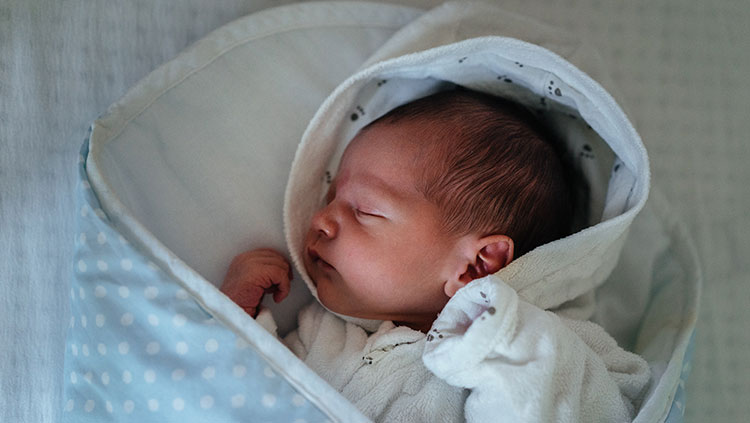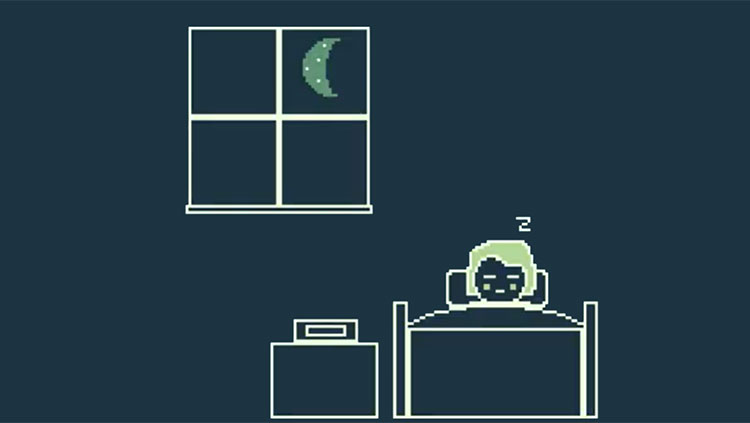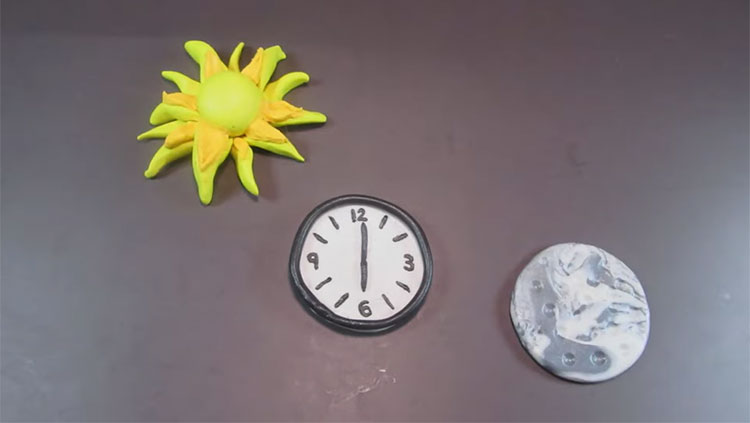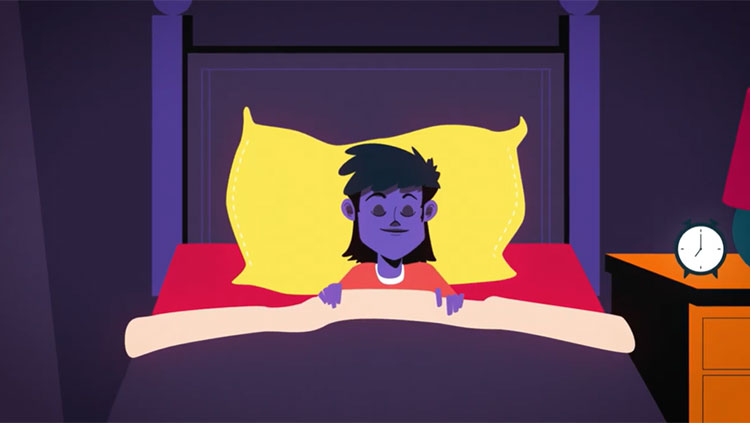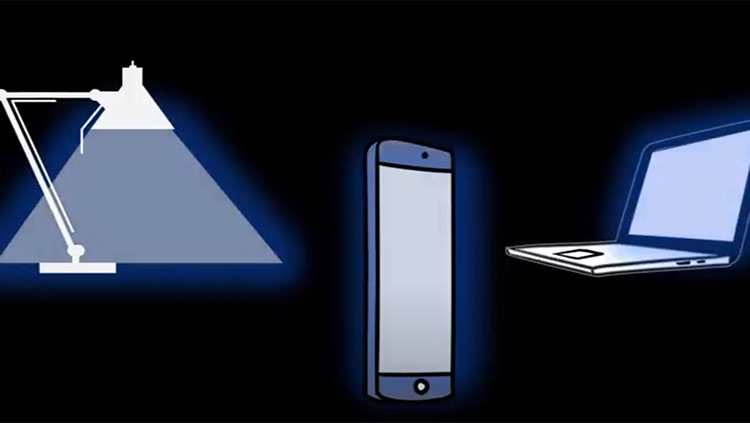How Learning Happens in the Brains of Sleeping Babes
- Published27 Apr 2022
- Author Carolyn Wilke
- Source Knowable Magazine
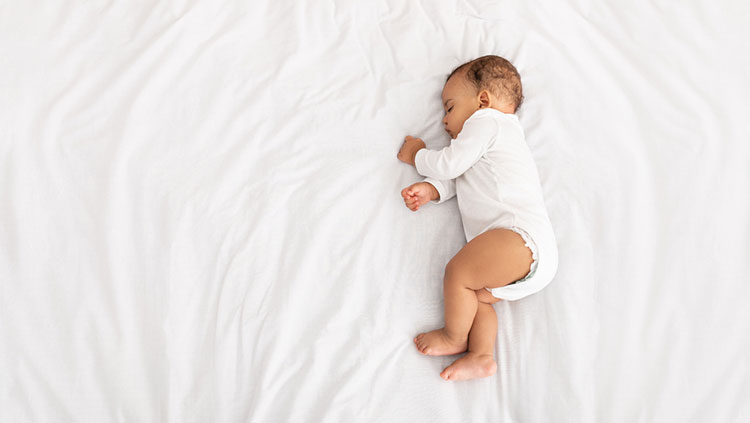
Dozing in a bassinet, a newborn baby wears a stretchy cap fitted with more than 100 soft electrodes. A low beep sounds, and she squints. Nearby, scientists watch jagged lines moving across a computer screen, recording electrical activity in the infant’s brain. The scientists want to know what’s going on in there — and that tiny squinting action suggests that the baby has been learning while she sleeps.
A newborn’s job is to learn about and adapt to everything in their environment, says William Fifer, a developmental neuroscientist at Columbia University Irving Medical Center in New York. Yet newborns spend some 70 percent of their time asleep. So Fifer and developmental psychologist Amanda Tarullo, now at Boston University, decided to see if they could catch learning in action while babies slumber.
Infants just one or two days old, the researchers found, can learn that a tone predicts a gentle puff of air — such that, eventually, the infants blink after hearing the tone alone, much as Pavlov’s famous dogs drooled in response to certain sounds that initially had been followed by food.
In adults, the importance of sleep for learning has been well established through decades of research. But much less is known about how sleep and learning interact in newborns, let alone how that relationship changes as infants grow into toddlers and preschoolers.
Naps are especially puzzling. Studies suggests they’re crucial to early learning, but most kids naturally stop napping between the ages of three and five. No one knows why, but a cadre of researchers is on the case. Their emerging understanding of the tangled relationship between napping and learning may eventually help parents, preschools and policymakers make decisions that improve kids’ health and learning.
Sleeping on it
Sleep in infants and young children looks very different than it does in adults, and sleep patterns change dramatically as kids develop. Newborns sleep some 16 to 18 hours a day. At first, they sleep randomly throughout the day, but by about six months their inner clocks sync up with the day-night cycle. By about 12 months, infants snooze mostly at night, with a couple daytime naps. By around two years, most kiddos are down to one nap a day.
Research suggests that napping plays an important role in many important things infants learn. “Sleep is crucial for earliest word learning,” says Manuela Friedrich, a neuroscientist at Humboldt University of Berlin. In a 2015 study, Friedrich’s team showed this by presenting 90 infants ages nine to 16 months with images of unknown objects — things that looked like dumbbells or Tinkertoys, for instance.
While viewing each image, the children heard the object’s name — a made-up word, such as “bofel” or “zuser” — and electroencephalogram (EEG) recordings captured their brains’ responses. An hour or two later, the researchers tested the infants’ recollection by showing the images again, either paired with the object’s name they had heard before or a different made-up word. Because the infants were too young to rattle off the objects’ names, the researchers examined the EEG recordings for evidence that they’d made the connection. Previous research had identified certain features of an EEG trace — like a voltage blip at a particular time — that appear when people hear something unexpected. In Friedrich’s study, the presence of a blip would show that an infant was surprised to hear the object paired with the “wrong” word, indicating that the baby had earlier learned a word-object association.
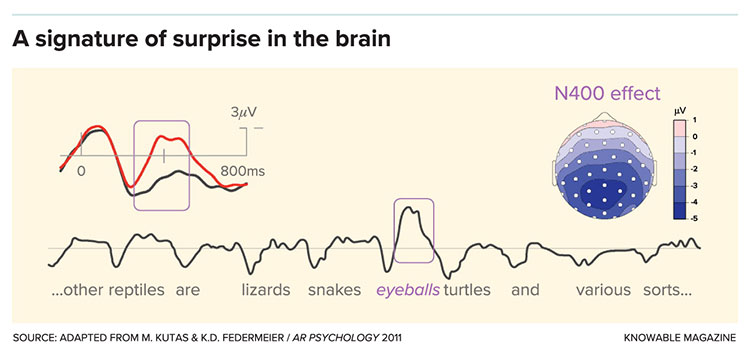
The EEG recordings suggested that kids who’d taken a nap before the memory tests remembered the word-object pairs they had seen previously. Non-nappers, on the other hand, did not. Not only that, but the infants who dozed appeared to group the objects they had learned into categories: When they saw new objects similar to ones they’d seen before, their EEG activity suggested they were expecting a previously learned word. In other words, Friedrich says, “while infants were sleeping, their brains extracted the gist of previous experiences.”
In the same study, Friedrich and her colleagues also found that babies’ ability to lump objects into categories after seeing several examples correlated with the presence of an EEG feature called sleep spindles during naps: fast bursts of electrical activity. Higher-amplitude sleep spindles — ones with larger swings of voltage — occurred only in kids who learned to generalize the words.
These sleep spindles often co-occur with slow-wave sleep, a particular frequency of slowly oscillating electrical activity revealed in EEG recordings. That illustrates an interesting difference between infants and adults. In adults, slow waves occur during deep sleep and have been linked to memory consolidation, the process by which short-term memories formed during the day are turned into more enduring memories. But children experience more slow waves during naps than adults do.
Naps may help youngsters consolidate memories at a time when they’re learning vast amounts of crucial information. “The science seems to suggest that there’s a unique role of napping” in early cognitive development, says Simona Ghetti, a developmental psychologist at the University of California, Davis, and coauthor of a 2020 article in the Annual Review of Developmental Psychology on memory in the developing brain.
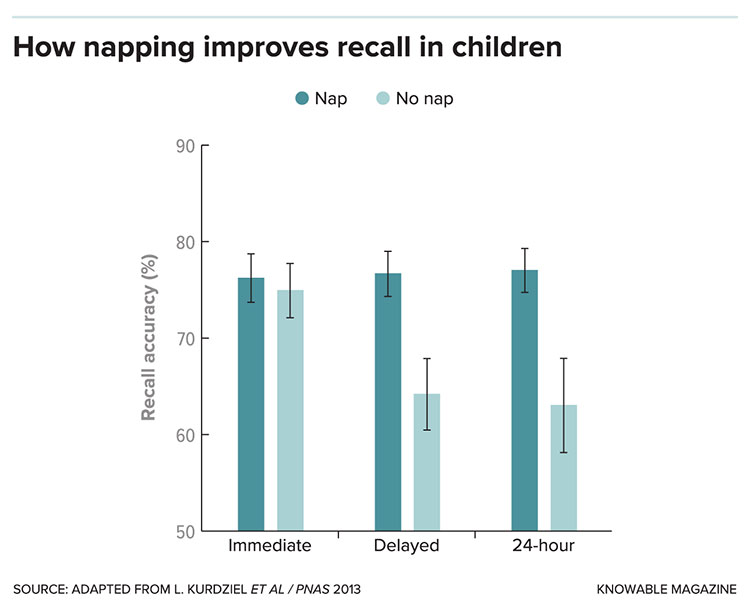
Naps also seem to help babies make sense of sentence structure, according to work by cognitive psychologist Rebecca Gómez of the University of Arizona in Tucson. When Gómez and colleagues exposed 48 15-month-olds to a made-up language, with strings of words such as “vot wadim jic” and “vot kicey jic,” kids who napped seemed better able to grasp patterns, such as catching on to the fact that the first word of a sentence always determined the third word. The researchers view this as a step toward understanding grammar.
In the study, the kids first heard such sentences while playing quietly at home, and afterward, some kids napped while others stayed awake. A few hours later, parents brought the kids to Gómez’s lab, where the researchers replayed the strings of words and tracked how long the babies paid attention by measuring how long they gazed in the direction of the speaker that played the sound — a common method used by researchers to assess attention in kids too young to talk.
Nappers and non-nappers alike paid attention to strings of words they’d heard previously, suggesting they remembered those sentences. But babies who napped also tuned in to new sentences that followed the same rules, hinting at a more general understanding. Gómez says the finding suggests that napping helps babies extrapolate what they’ve learned, teaching them a template they can apply to new situations.
In older children, naps may help with more than just language, according to work by Rebecca Spencer, a cognitive neuroscientist at the University of Massachusetts Amherst. In a 2020 study, Spencer and her graduate student Sanna Lokhandwala mimicked a common preschool activity: story time. They created several books that told a short story — about a day at the zoo, for example, or a cookie-baking adventure. In Spencer’s sleep lab, a researcher read these books to three- to six-year-olds, pointing out the pictures along the way. To test the kids’ recall immediately after hearing a story, the researchers asked them to place in order a set of pictures from the books. Then some children napped for up to two hours while others stayed awake, drawing or doing puzzles.
The researchers found that nappers more accurately recalled the order of events in a second memory test. These kids also performed better on the same test the next day. And within the group of nappers, EEG recordings revealed that those who had spent more time in slow-wave sleep tended to have more accurate memories of the stories.
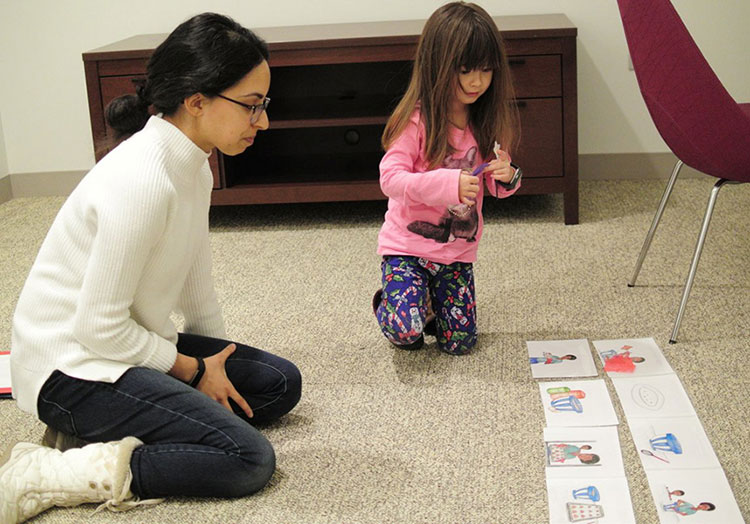
Why stop napping?
When kids who take naps regularly miss their naps, they tend to fare poorly on memory tests, researchers have found. “Naps are awesome — they’re doing all of this important stuff for kids at a really critical time,” Spencer says. But that presents a puzzle, she adds, since kids eventually give up their regular naps. “Why stop napping when it’s so important?” Because kids transition out of naps over a fairly wide age range, from three to six years old, she suspects that the answer may have to do with brain development: Perhaps at a certain point, which varies from child to child, the brain has changed in some yet to be discovered way that makes napping less crucial for learning.
Some evidence for this comes from Spencer’s collaboration with Tracy Riggins, a developmental cognitive neuroscientist at the University of Maryland in College Park. Using magnetic resonance imaging (MRI) to scan children’s brains, they are focusing on the hippocampus, a brain structure important for creating new memories.
Spencer and Riggins hypothesize that the development of the hippocampus drives the transition away from regular napping. Research with lab animals and adult humans suggests that the hippocampus acts as short-term storage for new information learned during wakefulness; during sleep, those memories get transferred or distributed to the cerebral cortex for longer storage.
Spencer likens the hippocampus to a bucket. Early in development, when the bucket for holding memories is small, it has to be emptied more frequently, during sleep. Young children do this by napping. When little kids who are habitual nappers are deprived of a nap, they forget a lot of information, Spencer says. But as the hippocampus develops, so does its capacity. “If I’m more mature, and I have a bigger hippocampus, I can hold more without having to empty my bucket,” she says. Spencer and Riggins think this may explain why the need for naps diminishes as kids age.
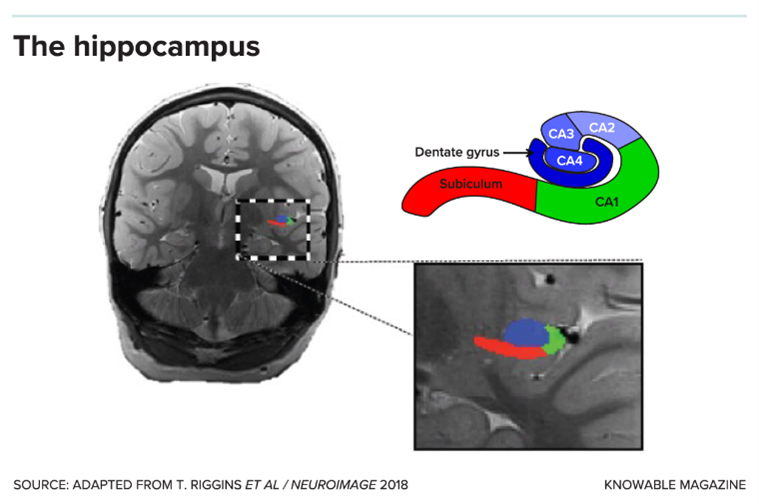
The two scientists are now looking to see how kids’ brains change as they stop napping. In a 2020 study of 200 kids ages four to eight, the researchers analyzed brain scans from a snapshot in time. In four- to six-year-olds, Spencer and Riggins found some intriguing correlations between the size of two subregions of the hippocampus and the kids’ sleep habits. A region called CA2-4/DG was larger in kids who slept more, including both naps and nighttime sleep. Meanwhile, another region called CA1 tended to be smaller in kids in this age range who had stopped napping. It’s not clear yet whether these differences might be part of what drives kids to drop naps.
These two hippocampus regions may perform distinct — and complementary — roles in memory, Riggins says. Neuroscientists have proposed that, in adults, the CA2-4/DG region tracks the differences between similar memories. The CA1, in contrast, may help make connections, for instance between a person’s face and name. But researchers don’t know what these subregions are doing in infants and kids.
It’s still early for this work, and the scientists don’t yet know if other brain regions may also be involved with the transition out of habitual naps. In a follow-up survey with around 65 kids, Riggins and Spencer are now using MRI scans to track brain changes in individuals as they grow, which may allow researchers to catch hippocampal changes as they happen, and to establish stronger connections between brain development and napping.
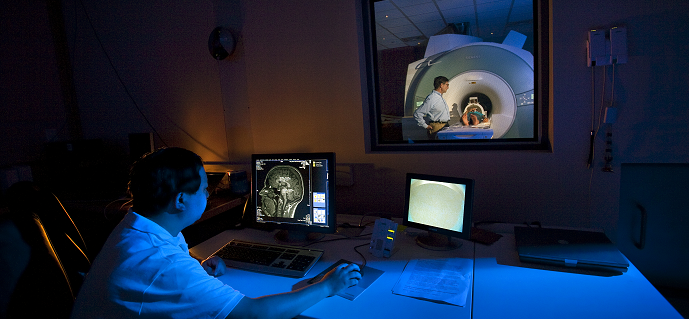
Decisions for parents and preschools
Researchers hope findings like these can eventually help improve education and sleep for young children, and help policymakers and parents make better decisions about prioritizing naps and fitting them into busy schedules.
In the United States, politicians and school superintendents have argued that preschools should focus on instruction, not sleeping. And in some parts of the country, educational standards have shifted to reflect that idea. For instance, in Massachusetts where Spencer works, teachers tell her the amount of preschool time set aside for napping has decreased in the last 10 to 15 years. Standards also have loosened around making classrooms conducive to sleep, for instance by enabling teachers to darken rooms during naptime. In some schools, parents can choose to send younger kids to swim lessons or Zumba fitness classes instead of napping, Spencer says. She’s worried about the effect that has on learning.
For very young kids who are habitual nappers, missing naps harms their cognitive performance — they’ll lose information they’ve learned in the morning without an afternoon nap, Spencer says. She wishes parents were more aware of the benefits of napping. “If somebody is making a policy decision, or you’re letting parents choose between the nap room and the non-nap classroom, I think it should be an informed choice.”
At the same time, forcing kids who’ve stopped napping to be still and quiet during classroom naptimes also could have undesirable consequences. Sally Staton, a developmental psychologist at the University of Queensland in Brisbane, Australia, and colleagues have observed children during blocks set aside for napping in 130 Australian preschool classrooms. Less than a third of kids were sleeping during mandatory naptimes, she and her team reported in 2016 in Behavioral Sleep Medicine. These wakeful kiddos would often appear distressed, for instance crying or acting out during naptime.
Part of the problem is the uncertainty around what’s typical in development: When do kids give up their naps? The data are limited, especially for low- and middle-income countries. A recent analysis by Staton and others that evaluated 44 napping studies from around the world showed huge variations, with some kids quitting naps as early as age two and others still napping after age six. In this way, napping is akin to other developmental milestones like learning to walk and talk, which are also highly variable from child to child, Staton says. Some kids start walking as early as nine months, while others learn to walk at 18 months. That range is completely normal. “We need to normalize the fact that sleep is very diverse, and that not every child is the same,” she says.
Understanding how sleep develops may also translate into better care for kids. “We know developmental trajectories for height and weight … we don’t have that for the brain,” says Riggins. She hopes that the MRI scans she’s gathering can help establish what’s normal in the brain’s path to maturity. By pulling on these threads — of cognition, sleep and brain development — researchers are starting to capture how they intersect and weave together to shape learning and memory early in life.
CONTENT PROVIDED BY
Knowable Magazine is an independent journalistic endeavor from Annual Reviews.
What to Read Next
Also In Sleep
Trending
Popular articles on BrainFacts.org




